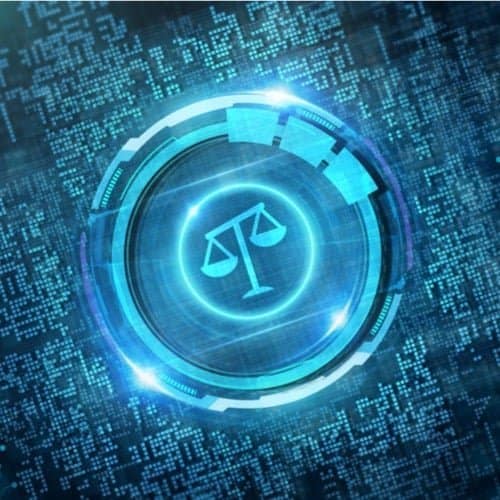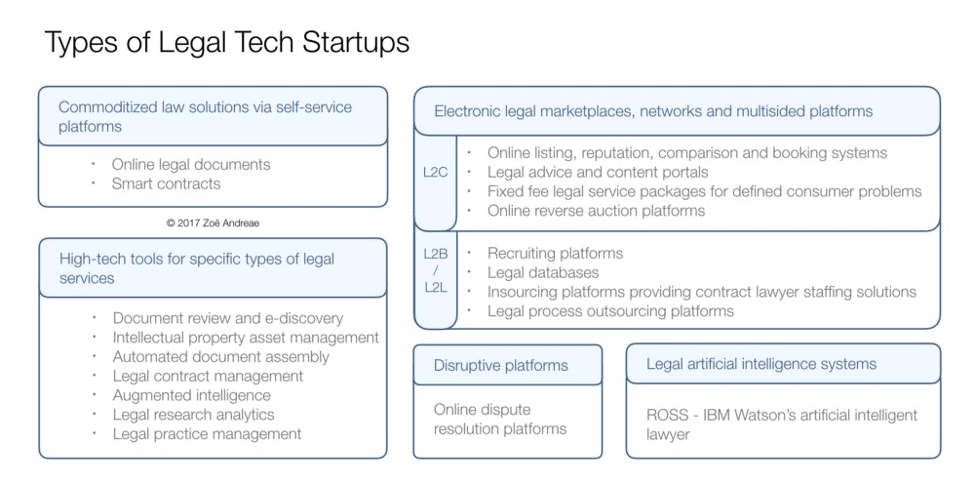Legal Technology
What is legal technology? Legal technology uses new technologies, from artificial intelligence to blockchain technology, to offer legal services better and more efficiently and help us tackle regulatory and compliance burdens more efficiently and more effectively. Technology in the legal sector is also referred to as legal tech, law technology (law tech), and regulatory technology (reg tech).
Historically, the term legal technology has been used to refer to law firm technology used to help with practice management, accounting, billing, and document storage and retrieval. But, from around 2011, the term has evolved to encompass solutions that make access to justice easier for the public, sometimes without involving a lawyer, and connecting the public to lawyers through online marketplaces and matching services.
Legal technology is big business. In 2019, the industry generated USD 17 billion worldwide. The law and tech startup market is projected to grow at a compound annual growth rate (CAGR) of 28% and achieve revenues of USD 2.5 billion by 2025.
But, despite this impressive growth, there is a paradox in the legal marketplace. Consider the following 2019 stats for the United States from the Global Insights on Access to Justice Survey by the World Justice Project:
- 66% of the people surveyed experienced a legal problem.
- 76% knew where to get advice.
- Only 33% of those surveyed were able to get help in terms of advice and representation.
- Only 48% of those surveyed were able to resolve the problem.
- For those who were able to solve the problem, it took at least eight months.
- 45% of those who experienced a problem had a hardship as a result.
These are stats from the United States, which has one of the highest ratios of lawyers per capita. The United Nations estimates that around four billion people worldwide are excluded from the rule of law. If the legal industry can tap into this enormous opportunity, it would be a game-changer both for lawyers on an individual basis and the industry at large.
Think about the last time you had to enter into an important legal contract – for example, a new employment contract for a new job, or a lease for a new apartment. You probably would have liked to consult a lawyer. But you probably didn’t, as you thought, like many others, it would be too expensive. Think about when you were confronted with a situation where you needed to understand your rights, like a family member’s sudden death or being unexpectedly fired from your job. Was finding the right information easy? Probably not. This situation is the norm in most countries around the world.
Using the latest innovations in the fields of legal technology and regulatory technology – law tech and reg tech respectively for short – will not only change the centuries-old lawyer profession but will allow the general population to change its interaction with the law conceptually. And this will have an impact on billions of people around the world.
Table of Contents
Different Types of Legal Technology
According to Bucerius Law School and Boston Consulting Group in their study How Legal Technology will change the business of law, there are three main types of legal technology:
- Enabler technologies: These technologies deal with the digitizing of legal data.
- Support process solutions: These include solutions for back-office work, accounting, business development, human resources, case management, and document management. Paralegals often do the latter. Paralegal technology refers to tech in this space.
- Substantive law technology: The first two have to do with administrative issues. Legal technology companies offering substantive law solutions provide basic and advanced support solutions and commoditized law solutions for actual litigation and case analysis.

The second classification of the legal technology framework can be found in the Stanford Legal Codex database. There are nine types of legal technology in this database:
- Marketplace
- Document automation
- Practice management
- Legal research
- Legal education
- Online dispute resolution
- E-discovery
- Analytics
- Compliance
The third classification of the legal technology framework was offered by Zoe Andrea, the CEO at Lecare, a legal technology solutions company. In her master’s thesis, she came up with five legal tech startup classifications within the legal framework:
- Commoditized law solutions: These are do-it-yourself services – for instance, document drafting platforms where you can make simple contracts, wills, divorce documents, etc. Smart contracts based on blockchain technology are also in this category.
- Electronic legal marketplaces, networks, and multisided platforms: This technology connects lawyers to customers. Examples of such portals include:
 Online listing, reputation, comparison, and booking systems.
Online listing, reputation, comparison, and booking systems.- Legal advice and content portals.
- Fixed fee legal service platforms for defined consumer problems.
- Online reverse auction platforms.
- Recruiting platforms.
- Legal databases.
- Insourcing platforms providing contract lawyer staffing solutions.
- Legal process outsourcing platforms.
- High-tech tools for specific types of legal services: These technologies include:
- Document review and e-discovery.
- Intellectual property asset management.
- Automated document assembly.
- Legal contract management.
- Augmented intelligence.
- Legal research analytics.
- Legal practice management.
- Disruptive Platforms: These include online dispute resolution systems that are completely revolutionizing the legal profession.
- Legal artificial intelligence (A.I.) systems: The best example of this is ROSS, an AI software powered by IBM’s Watson technology that helps thousands of US lawyers work faster and smarter.

Importance of Legal Technology
Why is legal technology important? The legal industry is traditionally risk-averse and remains so to this day. It has been very slow to adopt technology solutions. Slightly over a decade ago, there were hardly any legal technology companies. Numbers have increased more recently, and legal tech has been gaining traction, especially as the COVID-19 pandemic has made it difficult to access legal services.
The factors driving innovation in the legal services market include:
- Costs: There is a high expectation of value for legal fees paid. In-house departments have also come under greater scrutiny for the amount spent on legal services.
- Forced innovation: The legal profession has been slow to innovate but has been forced to do so due to the invention of legal technologies that have commoditized many law solutions.
- Scrutiny by regulators: Regulators in many jurisdictions have become very aggressive in checking lawyers to ensure they are not used as conduits by criminal enterprises.
Innovation has increased the efficiency and productivity of legal workers, and the data to plan future operational strategies now exists. The importance of technology in law can be identified in five different areas:
 Increased Geographical Reach: Technology has helped law firms go global. The commoditization of some legal services has made it possible to provide them across borders. For example, where contract law is similar across jurisdictions, a customer can choose a location from a drop-down menu and download a basic contract. Therefore, law firms that have leveraged technology have increased their market size, and technology is fueling their growth.
Increased Geographical Reach: Technology has helped law firms go global. The commoditization of some legal services has made it possible to provide them across borders. For example, where contract law is similar across jurisdictions, a customer can choose a location from a drop-down menu and download a basic contract. Therefore, law firms that have leveraged technology have increased their market size, and technology is fueling their growth.- Better Transparency: Legal technology has brought transparency to the opaque manner in which the industry has traditionally operated. Clients can now have a clear view of their case progress, fees, and other pertinent information. This client-centric approach bodes well for the industry.
- Better Use of Resources: With legal technology, human resources can be redeployed to tasks that have a greater impact on learning and fostering customer relationships. For example, rather than have paralegals working on monotonous document management, they can spend more time on legal research, in courtroom sessions where they can learn, or visiting clients.
- Faster Processing and Time Management: When used correctly, technology is faster and more efficient than the best human worker. AI solutions can deliver research results faster and analyze documents in milliseconds. What previously took days to complete can now be done in a matter of minutes.
- Fewer Errors: Errors can be costly, especially when documents have already been submitted to the courts. With AI, the chances of errors are greatly reduced.
Examples of Legal Technology
There are several examples of legal technology. Below are some of the best legal tech examples where great strides have occurred.
Legal Chatbots
Imagine that you have a legal question and can simply take out your smartphone and ask a robot lawyer for the answer. Well, some legal technology startups are building just that – legal chatbots. These messaging apps allow you to ask questions as if you are talking to a human lawyer. But, instead, you are talking to a computer program that can answer your questions anytime and anywhere.
Take the example further and imagine that you separate from your partner and want to know the relevant custody rules that apply with regards to your children? Or you are a single mom and want to know what state benefits are available to you. A legal chatbot can now provide fast answers.
While the most complex and bespoke legal questions will and should be answered by human lawyers, the reality is that basic legal answers are now programmable into decision trees and delivered via chatbots to the public via tools that people use daily, such as Facebook Messenger.
Legal chatbots become even more powerful when used to help those who need it the most. Think about refugees looking at making asylum claims. In that instance, the chatbots accessible by any smartphone can answer relevant questions, determine that individual’s rights, propose some options, and potentially file on that refugee’s behalf. Legal tech allows us to help the people who need access to legal solutions the most and do it in a cost-effective and scalable way.
With advances being made in voice recognition technology, and voice as a user interface, these services can be offered to the over 770 million people worldwide who are illiterate and cannot read and write. Most of these people are in developing countries and are women.
Legal Research
But even when you look beyond the most vulnerable, the reality is that legal services are still not accessible to even the middle class. One of the things lawyers do is to peruse hundreds of past cases to find the specific ones that would help a present client’s case. That is quite common in the practice of law, but it is a bit like sending a human to find a needle in a haystack. According to some studies, lawyers spend up to 75% of their time on non-client facing billable work such as legal research, court filings, and administrative/managerial work. This makes legal services very costly and acts as another barrier to legal services.
The good news is now we have many legal technology solutions built by startups powered by artificial intelligence. These applications can go through all the available case law and intelligently flag and summarize the ones that the lawyer should focus on – not only on key terms but also on the context. This allows lawyers to reduce research time from hours or days down to minutes or even seconds – bringing down the cost of legal services and making it more accessible.

Anti-Money Laundering (AML) and Terrorism Finance
These technologies are also being used to solve big global problems at a cross-border and transnational level. Today, banks worldwide spend billions of dollars a year trying to spot and stop the movement of funds by criminal organizations and corrupt politicians. The goal is to prevent these funds from entering the global financial system. Once injected into the system, there is the chance they will be used to fund crimes such as terrorism, human trafficking, bribery of public officials, and other practices that end up affecting us all. The process of identifying illicit funds is complicated. The United Nations Office on Drugs and Crime estimates that the global volume of money laundering transactions worldwide is between $1 to $2 trillion a year, or 2% to 5% of global Gross Domestic Product (GDP). Law enforcers are only able today to stop less than 1% of that amount. This means that despite all efforts, law enforcement is losing the war. One of the reasons is that the process is still very manual. It is very costly, time-consuming, and prone to mistakes.
 Thankfully, many legal technology solutions in use and development can do the work done today by humans better and faster. Once plugged in, these solutions spot patterns in financial data that a human money laundering officer would never be able to spot. And the beauty of the solutions is that the more they are “trained” and fed data, the more accurate they become, allowing law enforcers to get one step closer to stopping illicit funds from entering the global financial system.
Thankfully, many legal technology solutions in use and development can do the work done today by humans better and faster. Once plugged in, these solutions spot patterns in financial data that a human money laundering officer would never be able to spot. And the beauty of the solutions is that the more they are “trained” and fed data, the more accurate they become, allowing law enforcers to get one step closer to stopping illicit funds from entering the global financial system.
To accurately predict the future of legal technology, one must examine the history of disruptive technology more broadly and take lessons from what happened in other industries.
In the early 1990s, file-sharing technology was created, and music sales took a big hit –music companies laid-off employees. When the CD was first invented, music labels celebrated because they could sell the same product repeatedly because of a format change. But what the labels didn’t appreciate was that the unprotected CD, the Internet, and MP3 compression technology, formed a perfect storm that would decimate their business.
The music labels and the publishers fought back, and the law was on their side. File sharing music without permission was against the law. But it didn’t matter – people wanted to do it and continued to do so. The music labels sued everyone to make it stop. They were enforcing the law, but all they did was alienate their market. The labels were fighting the technology itself, and that’s not a great strategy because technology always wins. Instead, the labels should have been leveraging the technology and tapping into the new opportunity awaiting them.
Kodak is another example of a great company that failed to leverage technology despite having the first patent to a digital camera. The firm once thought it was in the business of selling camera film, but it was really in the social expression business. And, if Kodak had only realized that, it might still be as relevant today as it was years ago.
Many entrepreneurs make a lot of money by inserting themselves into markets being disrupted away from the status quo, finding an inflection point, and then providing a solution. That is what Steve Jobs of Apple did when the music industry was disrupted by launching iTunes and the iPod.
Major League Baseball (MLB) has leveraged technological change. MLB makes more money than ever from radio and television revenue. But when the radio was first invented, major League baseball was afraid that nobody would ever go to the ballpark again to watch a game. Of course, it turned out fine.
The motion picture industry has also leveraged technological change even though Jack Valenti, one-time president of the Motion Picture Association, likened the original Sony Betamax video cassette machine to the Boston Strangler (a 1960s serial killer). He was convinced that nobody would ever go to the theater again if people could tape shows and watch movies at home. But, of course, it turned out fine. People go to the theater, watch the film, watch the same movie on cable or stream it over services like Netflix. We also buy the DVD, and the Motion Picture Association makes more money than ever.
Many other industries are experiencing change because of technology. Recent examples include the newspaper and taxi industry.
Let’s now consider the future of legal services by examining two technological developments that will profoundly impact the legal profession.
Blockchain Solutions
Future legal services become exciting when you consider the developments in blockchain technology. Blockchain is a decentralized database, basically not being stored in one location or under one person/entity’s control. It is also immutable, meaning that it cannot be changed once the transaction has been recorded. Blockchain will change many facets of our lives over the coming years. But it will particularly impact the field of law.
 For example, blockchain will profoundly change how real estate is bought and sold. Today, if you want to buy a house, you have to see a lawyer or notary, depending on whether you’re in a common-law or a civil law jurisdiction. That individual will perform some checks, say, to ensure that the house you are buying belongs to the seller, but also will try to verify that the title you’re purchasing is clear of any mortgages, liens, and other encumbrances. This process is as costly as it is inefficient. And this isn’t even the biggest problem. In many places around the world, the legal title may not even exist. According to the World Bank, 70% of the world’s population does not have access to proper land titling. To put that in economic terms, some experts estimate that the value of debt capital in which people do not have access to the legal title to the land, house, car, and other assets they own is around USD 20 trillion. This traps people into a vicious cycle of poverty, as it means many people cannot borrow money using the land or house they have as collateral. They could also lose the roof over their heads that they think they have paid for and own. They are at the mercy of corrupt government officials who are bribed to alter land titles.
For example, blockchain will profoundly change how real estate is bought and sold. Today, if you want to buy a house, you have to see a lawyer or notary, depending on whether you’re in a common-law or a civil law jurisdiction. That individual will perform some checks, say, to ensure that the house you are buying belongs to the seller, but also will try to verify that the title you’re purchasing is clear of any mortgages, liens, and other encumbrances. This process is as costly as it is inefficient. And this isn’t even the biggest problem. In many places around the world, the legal title may not even exist. According to the World Bank, 70% of the world’s population does not have access to proper land titling. To put that in economic terms, some experts estimate that the value of debt capital in which people do not have access to the legal title to the land, house, car, and other assets they own is around USD 20 trillion. This traps people into a vicious cycle of poverty, as it means many people cannot borrow money using the land or house they have as collateral. They could also lose the roof over their heads that they think they have paid for and own. They are at the mercy of corrupt government officials who are bribed to alter land titles.
Blockchain could be part of the solution. Putting land title transactions on a blockchain would make it cheaper to buy and sell real estate, as you don’t need lawyers to act as trusted intermediaries. But, most importantly, blockchain technology would make it practically impossible for corrupt government officials to alter land titles and take the property away from genuine owners. The advances being made in this space are impressive.
Smart Contracts
Contracts are a part of everyday life, from buying goods online to clicking and accepting terms and conditions you never read on a mobile app. The reality is that legal agreements are lengthy and ambiguous – in many cases, you need to rely on a third party to enforce it if the other party does not fulfill its obligations.
 Enforcing a contract is the most costly and time-consuming bit. You have first to find the other party, hire lawyers, go to court, and hope you end up with an impartial judge who sets the record straight. Blockchain can be part of the solution via smart contracts.
Enforcing a contract is the most costly and time-consuming bit. You have first to find the other party, hire lawyers, go to court, and hope you end up with an impartial judge who sets the record straight. Blockchain can be part of the solution via smart contracts.
Smart contracts insert programming code on certain blockchains, most notably the internal blockchain. It allows you to facilitate and execute contracts using blockchain technology. The smart contract code sets the rules, the obligations, and the benefits as a normal contract would, but the smart contract automatically executes upon a certain event. For example, let’s say you bet with your friends on the outcome of a football game. As soon as the final whistle blows, the winner would automatically get paid by the smart contract. Or imagine buying a travel insurance policy where the smart contract automatically pays you as soon as your flight is delayed.
Smart contracts allow us to code not only the obligations the parties have agreed to but automatically execute them upon the occurrence of public, verifiable, and available information.
The technology hasn’t reached the level of adoptability where we can get rid of traditional contracts. But some of the most long-standing problems in contract enforcement and counterparty risk will soon be a thing of the past.
All these are examples that will transform the world we live in over the coming years. However, it’s important to understand that we’re still in the early days.
A lot of the examples mentioned will succeed, but many of them will fail. Many people in the legal technology community are working with government regulators and legal practitioners to ensure that we have the right ecosystem to allow these technologies to flourish.
But the legal industry must be willing to change. It will be interesting to see if bar associations and law societies will embrace these new technologies. Will they try to block them as they compete with human lawyers – a bit like the taxi industry did with the arrival of Uber and other ride-sharing devices? Only time will tell.
Technology Leads and the Law Follows
The law has to change, conform to the new technology and the new ecosystem. Technology leads, and the law follows. It’s never the other way around. If that were the case, then the music industry could have sued file-sharing out of existence.
To demonstrate how the law changes, in 2018, the Music Modernization Act (MMA) came into force in the USA, essentially transforming the existing music licensing structure based on the Internet age. So, laws do change after technological developments, and now the winds of change are blowing again.
 3D Printing is changing the world. Like the music industry, manufacturing will be more about selling digital code than physical things. If you need a part for a car, your mechanic will buy the file and print the part in his shop. Or he may scan the broken part and print it or find it on Pirate Bay, and sometimes the original OEM manufacturer will never know and never get paid. We are moving from a mass production model to production by the masses, with a high customization level. Sneakers and prosthetics that fit the body, perfectly printed in all sorts of materials. Concrete, metal, biomaterials, food, even a fully functioning smartphone in years to come. If you need a kidney transplant in 15 years, perhaps you will one bio-printed for you. Whole houses, apartment buildings, office buildings have already been printed with very large 3D printers. Biz Stone, a co-founder of Twitter, tweeted that Nike may be a pure software company in 10 years as we will simply 3D print our sneakers.
3D Printing is changing the world. Like the music industry, manufacturing will be more about selling digital code than physical things. If you need a part for a car, your mechanic will buy the file and print the part in his shop. Or he may scan the broken part and print it or find it on Pirate Bay, and sometimes the original OEM manufacturer will never know and never get paid. We are moving from a mass production model to production by the masses, with a high customization level. Sneakers and prosthetics that fit the body, perfectly printed in all sorts of materials. Concrete, metal, biomaterials, food, even a fully functioning smartphone in years to come. If you need a kidney transplant in 15 years, perhaps you will one bio-printed for you. Whole houses, apartment buildings, office buildings have already been printed with very large 3D printers. Biz Stone, a co-founder of Twitter, tweeted that Nike may be a pure software company in 10 years as we will simply 3D print our sneakers.
The future of legal tech portends a scenario where there will be profound changes in commercial laws. Think about the ramifications for construction regulations, manufacturing regulations, Food and Drug Administration (FDA) Regulations, Product Liability Law, and Intellectual Property law. Gartner analysts predict $100 billion in annual intellectual property losses from 3D printing beginning in 2018. On-demand printing is going to reduce the need for large inventories, reducing warehousing costs. Amazon and UPS are already aware their businesses are going to change. UPS is handling this threat to its warehousing business in a proactive way. It has opened 3D printing hubs in Louisville, Europe, and recently in Singapore. 3D technology will disrupt many things, but new businesses will inevitably be born, inserted into the markets disrupted by 3D printing, and entrepreneurs will find the inflection points and provide solutions and a new status quo, and jobs will be created.
Below is a patent for an early digital camera. It was filed in May of 1977 and issued in December of 1978 to Kodak.
 Kodak had the knowledge and the power to leverage a digital camera and sell it in the late seventies. When senior Kodak executives were told about the invention, they said to its two employees who invented it, “That’s cute but don’t tell anyone about it,” because it was filmless technology. Unfortunately, you can never put the technological genie back in the bottle once it is unleashed to preserve the old model. We all know we cannot avoid change simply because we want to, whether it occurs in our personal lives or our businesses.
Kodak had the knowledge and the power to leverage a digital camera and sell it in the late seventies. When senior Kodak executives were told about the invention, they said to its two employees who invented it, “That’s cute but don’t tell anyone about it,” because it was filmless technology. Unfortunately, you can never put the technological genie back in the bottle once it is unleashed to preserve the old model. We all know we cannot avoid change simply because we want to, whether it occurs in our personal lives or our businesses.
Lawyers must understand this and look for the opportunity that exists due to change, even though the law profession has not been innovative historically. Law firms investing in technology will thrive, while those that don’t will be weeded out through natural attrition.
In the US there are more than 1.3 million licensed lawyers. That does not even include the large number of paralegals and regulatory staff that do a lot of the monotonous and time-consuming work. Many studies over the years have tried to predict the impact legal technology will have on lawyers. Some indicate a modest number of legal jobs will disappear while other, more extreme studies predict law firms’ structural collapse. The reality is more nuanced than that – many jobs will disappear because many monotonous, regular, time-consuming work done by lawyers will disappear. But technology is still very far from disrupting some of the real value-added work that lawyers do, like strategizing, negotiating, making common sense judgments, or even visiting a client in jail. New jobs will also be created – think about smart contract coating lawyers or regulatory data scientists. The next generation of legal talent needs to be ready for these roles before this new reality.
Legal Technology Tools and Solutions
You may be wondering if there is a difference between tools and solutions. Let’s put it in perspective – a tool is a screwdriver, whereas a solution is a team of carpenters. Legal technology tools refer to stand-alone legal technology software in the legal profession that helps lawyers accomplish a specific task or series of tasks. Legal technology solutions are comprehensive services offered by legal technology firms that help law firms with full practice management.
Legal Technology Tools
Below are five examples of legal tech software that help lawyers work more efficiently:
- Drafting software: Lawyers must have strong writing skills. A good amount of their time is spent on drafting, proofreading, and editing documents. Drafting software streamlines the process. Most tools come with proofreading, citation validation, and a feature to customize and update authority tables.
- Case analysis and management software: A legal case entails organizing facts, building chronologies, reviewing documents, witnesses and expert tracking, task and workflow management, and much more. Without case analysis and management software, a litigator can easily get lost in the maze. Many contemporary legal technology tools have features that allow lawyers to collaborate on cases.
- Document management software: Document management software is now mostly offered as Software-as-a-Service (SaaS). Lawyers can store documents in the cloud, and annotate, share, and collaborate with their colleagues. Some applications also allow users to convert documents into different formats, for example, searchable PDFs. Data security capabilities are standard features due to the sensitive nature of legal work. Lately, SaaS providers are building AI functions into these applications to search and extract information from documents.
- E-Discovery software: Discovery, the pre-trial procedure of obtaining evidence from the other party or parties, is the most time-consuming process of a lawsuit. E-discovery software is a game-changer that allows litigators to retrieve evidence quickly and cost-effectively from several electronic sources. Applications powered by artificial intelligence helps lawyers identify relevant evidence, review, process, and tag it.
- Calendaring software: Perhaps more than any other profession, lawyers are controlled by deadlines. There are filing deadlines, the statute of limitation deadlines, court-imposed deadlines, and many events that must occur within a specified time. Without a proper method to manage the calendar, a lawyer could end up missing an important deadline and jeopardize a client’s case.
- Time-tracking and task management software: Finally, as with all other professions, lawyers need time tracking and task management software to track billable hours.
Legal Technology Solutions
Most new technology for law firms is now packaged as comprehensive legal tech solutions that offer all the legal technology tools that a lawyer or law firm would need.
Below is a brief guide to choosing a legal technology solution for practice management:
- Know what to expect: You should figure out how much the solution costs and the security measures that the developer uses. It is not just about the application with the best user interface, that is easy to use, or compatible with your firm’s network.
- What you specifically need: Think about your unique needs and acquire software that best matches them. With software, what’s “good” is relative. It all depends on whether the solution will serve your specific needs. For example, do you need email management? Do you need the software locally installed on your server, or is a cloud-based solution fine? What is your subject matter? These are important questions. A personal injury lawyer has different requirements from a family lawyer. When talking to colleagues in the industry about what they like or don’t like, ask specific questions that reveal weaknesses or strengths from your point of view.
- Narrow down to a few choices: The next step is to whittle down your choices to a few options and start asking more specific questions. Find out how each feature works and try out the demos if they are available. There is no substitute for trying out the software before you get into a long-term commitment.